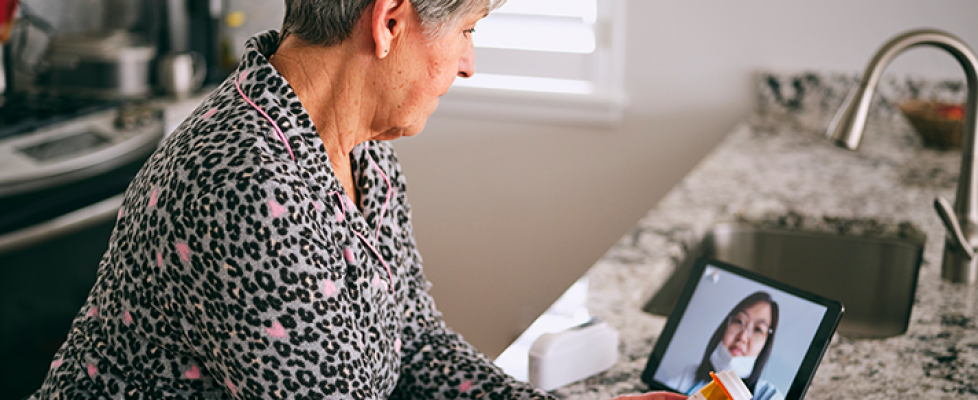Senior Telehealth Use Continues to Rise, Despite Home Health Limitations
By Bailey Bryant | June 15, 2020
The health care sector has long had the capability to use telehealth, but it took the COVID-19 emergency to prompt widespread adoption. After three months of the crisis, emerging data is now making the sweeping rate of that adoption clearer.
Seniors are among the most susceptible to the COVID-19 virus. Recently unveiled data suggests that telehealth usage has skyrocketed within this group, in particular.
The increased use of telehealth among the senior population is largely thanks to new Centers for Medicare & Medicaid Services (CMS) flexibilities allowing dozens of telemedicine services — though not yet home health — to be billed at the same rate as in-person visits.
“We dramatically expanded access to telehealth … for Medicare beneficiaries,” President Donald Trump said during a briefing in late April. “The number of Medicare patients using telehealth has increased from roughly 11,000 a week to more than 650,000 [people] a week.”
Independent data also shows a huge spike for the older population.
Research from NORC at the University of Chicago released in April showed that about 21% of seniors over 70 have received telehealth amid the coronavirus. Additionally, in late May, a Better Medicare Alliance (BMA) survey found that about a quarter of Medicare Advantage beneficiaries had received virtual care services in light of the coronavirus.
Then there’s the virtual care provider 98point6, which recently released data on how its telehealth usage has spiked in the past few months.
Since Q3 2019, the Seattle-based remote primary care provider has seen a 66% increase in visits from patients over the age of 50, with the demographic now making up 22% of all visits.
Those kinds of numbers were “unheard of four months ago,” Chief Medical Officer Brad Younggren told Home Health Care News.
“I think it is significant, but I think it’s not surprising,” Younggren said. “We know that the morbidity and mortality is higher as you age with this disease. … And then the other interesting thing is chronic disease management.”
Amid the coronavirus, a growing number of chronic disease management patients have turned to 98point6, with most of those in the older end of the spectrum. Patients with chronic diseases and other underlying conditions are especially susceptible to COVID-19.
Among all patients, 98point6 has seen a 200% increase in visits since January, with more than 40% related to COVID-19. To keep up with the demand, the remote primary care provider had to triple the number of physicians on its staff.
“I honestly think things will never be the same,” Younggren said. “Especially for sick chronic disease patients who would prefer not to come into a brick-and-mortar experience where they may be exposed to other patients illnesses.”
But for patients with chronic conditions and many seniors to be successfully cared for in home long term, home health care needs to be factored in. While CMS has opened up telehealth reimbursement for 85 different services, home health care has been left out of the equation.
Without telehealth reimbursement, some argue, home health providers must operate at a loss in order to provide appropriate virtual care.
CMS has said that it doesn’t have the power to reimburse home health providers for virtual visits. Instead, Congress has to act to make it happen.
Last month, Sen. Susan Collins (R-Maine) claimed she was working on it. On May 21, she said she planned to introduce a bill to create a framework for home health telehealth reimbursement “soon.”
Nearly a month later, that’s yet to happen. Even the National Association for Home Care & Hospice (NAHC), which often has inside insight into the inner workings of Washington, told HHCN it was not aware of any recent movement on the legislation.
However, that’s not to say additional flexibility isn’t coming. Legislative moves continue to suggest that Congress isn’t done helping Medicare providers yet.
Last week, U.S. Representatives G. K. Butterfield (D-N.C.) and Glenn Thompson (R-Pa.) introduced a bipartisan bill to codify Medicare reimbursement for community health centers and rural health clinics for telehealth services. The legislation is called the HEALTH Act.
“Access to telehealth has become more than just a convenience, but rather a critical necessity in America,” Rep. Butterfield said in a statement. “All patients, particularly our Medicare recipients, are in need of a solution to ensure access to telehealth services are free from undue barriers and restrictions.”
While the bill is a step in the right direction, it’s not quite the move home health providers are still waiting to see: home health telehealth reimbursement.

